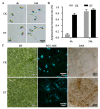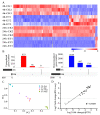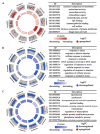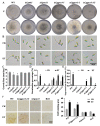Ethylene Promotes Expression of the Appressorium- and Pathogenicity-Related Genes via GPCR- and MAPK-Dependent Manners in Colletotrichum gloeosporioides
- PMID: 35736053
- PMCID: PMC9224669
- DOI: 10.3390/jof8060570
Ethylene Promotes Expression of the Appressorium- and Pathogenicity-Related Genes via GPCR- and MAPK-Dependent Manners in Colletotrichum gloeosporioides
Abstract
Ethylene (ET) represents a signal that can be sensed by plant pathogenic fungi to accelerate their spore germination and subsequent infection. However, the molecular mechanisms of responses to ET in fungi remain largely unclear. In this study, Colletotrichum gloeosporioides was investigated via transcriptomic analysis to reveal the genes that account for the ET-regulated fungal development and virulence. The results showed that ET promoted genes encoding for fungal melanin biosynthesis enzymes, extracellular hydrolases, and appressorium-associated structure proteins at 4 h after treatment. When the germination lasted until 24 h, ET induced multiple appressoria from every single spore, but downregulated most of the genes. Loss of selected ET responsive genes encoding for scytalone dehydratase (CgSCD1) and cerato-platanin virulence protein (CgCP1) were unable to alter ET sensitivity of C. gloeosporioides in vitro but attenuated the influence of ET on pathogenicity. Knockout of the G-protein-coupled receptors CgGPCR3-1/2 and the MAPK signaling pathway components CgMK1 and CgSte11 resulted in reduced ET sensitivity. Taken together, this study in C. gloeosporioides reports that ET can cause transcription changes in a large set of genes, which are mainly responsible for appressorium development and virulence expression, and these processes are dependent on the GPCR and MAPK pathways.
Keywords: GPCRs; MAPK; anthracnose; appressorium; ethylene; postharvest disease.
Conflict of interest statement
The authors declare no conflict of interest. The funders had no role in the design of the study; in the collection, analyses, or interpretation of data; in the writing of the manuscript; or in the decision to publish the results.
Figures








Similar articles
-
Mitogen-activated protein kinase cascade CgSte50-Ste11-Ste7-Mk1 regulates infection-related morphogenesis in the poplar anthracnose fungus Colletotrichum gloeosporioides.Microbiol Res. 2021 Jul;248:126748. doi: 10.1016/j.micres.2021.126748. Epub 2021 Mar 14. Microbiol Res. 2021. PMID: 33752111
-
CgSCD1 Is Essential for Melanin Biosynthesis and Pathogenicity of Colletotrichum gloeosporioides.Pathogens. 2020 Feb 20;9(2):141. doi: 10.3390/pathogens9020141. Pathogens. 2020. PMID: 32093195 Free PMC article.
-
Transcription Factor CgSte12 Regulates Pathogenicity by Affecting Appressorium Structural Development in the Anthracnose-Causing Fungus Colletotrichum gloeosporioides.Phytopathology. 2024 Aug;114(8):1832-1842. doi: 10.1094/PHYTO-12-23-0484-R. Epub 2024 Aug 10. Phytopathology. 2024. PMID: 38748933
-
The Mitogen-Activated Protein Kinase CgMK1 Governs Appressorium Formation, Melanin Synthesis, and Plant Infection of Colletotrichum gloeosporioides.Front Microbiol. 2017 Nov 10;8:2216. doi: 10.3389/fmicb.2017.02216. eCollection 2017. Front Microbiol. 2017. PMID: 29176970 Free PMC article.
-
A Colletotrichum gloeosporioides cerato-platanin protein, CgCP1, contributes to conidiation and plays roles in the interaction with rubber tree.Can J Microbiol. 2018 Nov;64(11):826-834. doi: 10.1139/cjm-2018-0087. Epub 2018 Jun 5. Can J Microbiol. 2018. PMID: 29870670
Cited by
-
The Involvement of the Laccase Gene Cglac13 in Mycelial Growth, Germ Tube Development, and the Pathogenicity of Colletotrichum gloeosporioides from Mangoes.J Fungi (Basel). 2023 Apr 23;9(5):503. doi: 10.3390/jof9050503. J Fungi (Basel). 2023. PMID: 37233214 Free PMC article.
-
Current status and future trends of eco-friendly management of postharvest fungal decays in tomato fruit.NPJ Sci Food. 2025 Jun 18;9(1):104. doi: 10.1038/s41538-025-00477-w. NPJ Sci Food. 2025. PMID: 40533482 Free PMC article. Review.
-
Appressoria-Small but Incredibly Powerful Structures in Plant-Pathogen Interactions.Int J Mol Sci. 2023 Jan 21;24(3):2141. doi: 10.3390/ijms24032141. Int J Mol Sci. 2023. PMID: 36768468 Free PMC article. Review.
-
Virulence perspective genomic research unlocks the secrets of Rhizoctonia solani associated with banded sheath blight in Barnyard Millet (Echinochloa frumentacea).Front Plant Sci. 2024 Oct 28;15:1457912. doi: 10.3389/fpls.2024.1457912. eCollection 2024. Front Plant Sci. 2024. PMID: 39529934 Free PMC article.
-
QTL and PACE analyses identify candidate genes for anthracnose resistance in tomato.Front Plant Sci. 2023 Aug 4;14:1200999. doi: 10.3389/fpls.2023.1200999. eCollection 2023. Front Plant Sci. 2023. PMID: 37615029 Free PMC article.
References
Grants and funding
LinkOut - more resources
Full Text Sources

